what angle in radians corresponds to 0.40 rotations around the unit circle?
\(\require{abolish}\newcommand\caste[0]{^{\circ}} \newcommand\Ccancel[ii][black]{\renewcommand\CancelColor{\colour{#1}}\cancel{#2}} \newcommand{\alert}[one]{\boldsymbol{\color{magenta}{#1}}} \newcommand{\blert}[ane]{\boldsymbol{\color{blue}{#1}}} \newcommand{\bluetext}[1]{\colour{blue}{#1}} \delimitershortfall-1sp \newcommand\abs[i]{\left|#one\right|} \newcommand{\lt}{<} \newcommand{\gt}{>} \newcommand{\amp}{&} \)
In the previous section, we introduced periodic functions and demonstrated how they can be used to model existent life phenomena like the rotation of the London Eye. In fact, at that place is an intuitive connexion between periodic functions and the rotation of a circle. In this section, we will use our intuition and formalize this connectedness by exploring the unit of measurement circle and its unique features that lead us into the rich world of trigonometry.
Many applications involving circles also involve a rotation of the circle so we must first innovate a measure for the rotation, or angle, between two rays (line segments) emanating from the eye of a circumvolve.
The mensurate of an bending is a measurement between two intersecting lines, line segments, or rays, starting at the initial side and ending at the concluding side. Information technology is a rotational measure, non a linear mensurate.
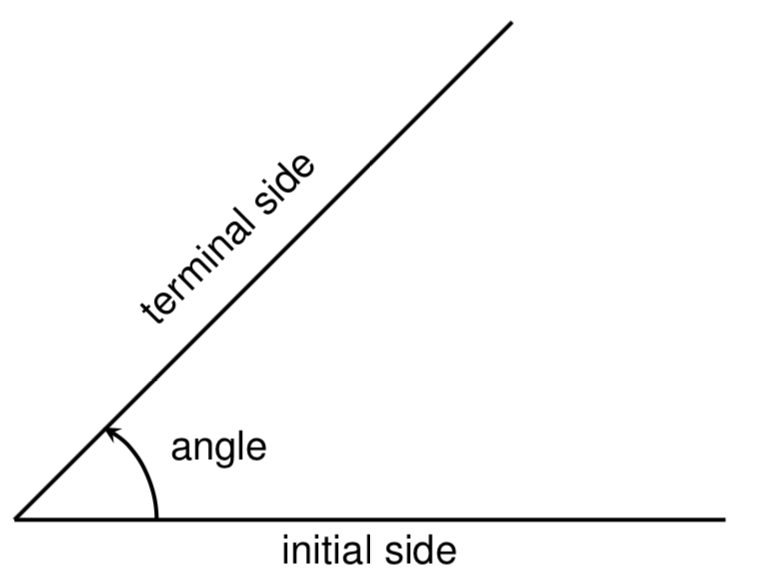
When measuring angles on a circle, unless otherwise directed, we mensurate angles in standard position: starting at the positive horizontal axis with a counterclockwise rotation.
Subsection Measuring Angles in Degrees
A caste is a unit of measurement of an angle. I rotation around a circle is equal to 360 degrees.
An angle measured in degrees should always include the degree symbol \(^\circ\) or the word "degrees" later on the number. For example, \(90^\circ=ninety\) degrees.
Example six
Requite the caste measure out of the angle shown on the circle.
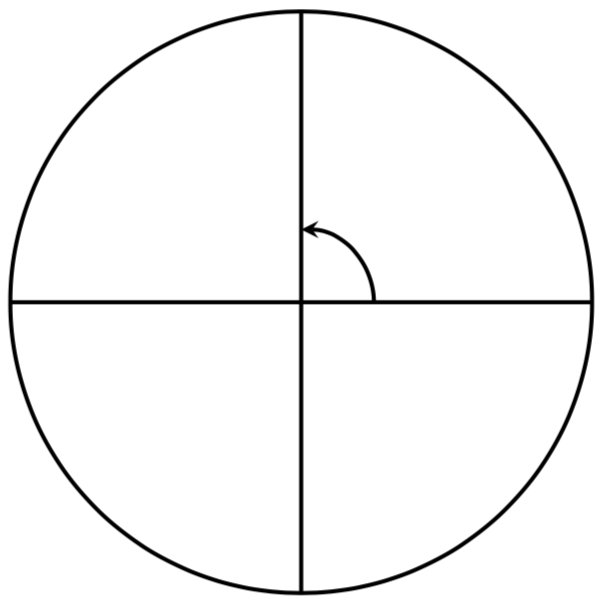
Solution
The vertical and horizontal lines split the circle into quarters. Since ane full rotation is 360 degrees, each quarter rotation is \(360^\circ / four = xc^\circ\text{.}\) 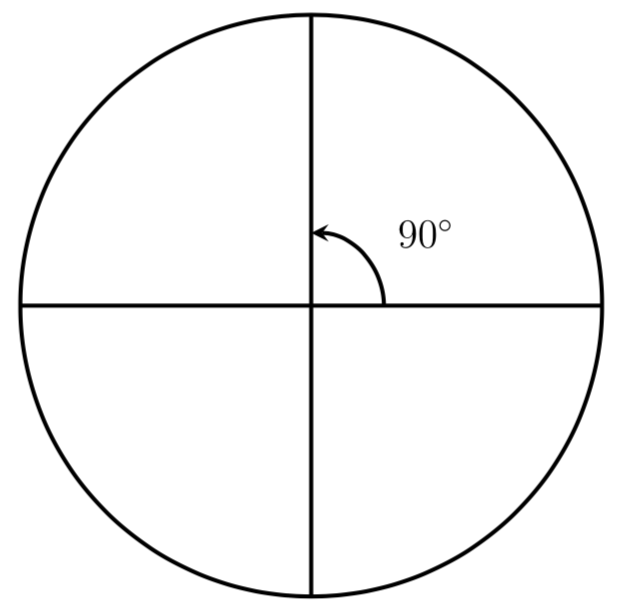
Example seven
Draw an bending of \(xxx^\circ\) on a circle.
Solution
An bending of \(30^\circ\) is \(1/3\) of \(ninety^\circ\) so by dividing a quarter rotation into thirds, we tin describe a line showing an angle of \(thirty^\circ\text{.}\) 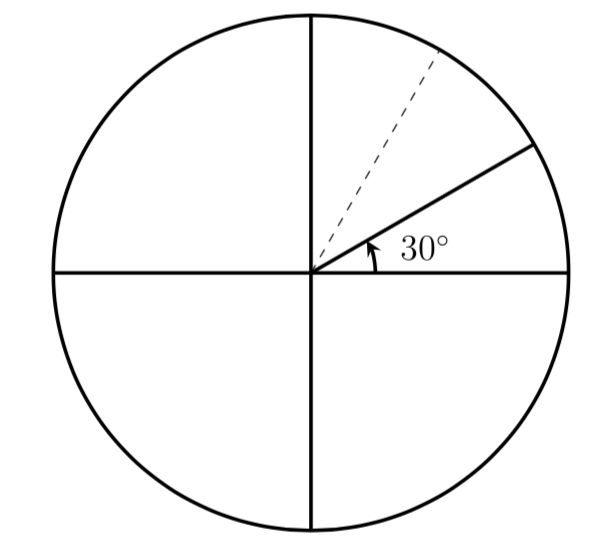
Notice that since there are 360 degrees in one rotation, an bending greater than 360 degrees would indicate more than 1 full rotation. Shown on a circumvolve, the resulting direction in which this angle'due south terminal side points is the aforementioned every bit another for an angle between 0 and 360. These angles are called coterminal.

After completing their full rotation based on the given angle, two angles are coterminal if they terminate in the same position, so their last sides coincide (point in the same direction).
Example ix
Notice an angle \(\theta\) that is coterminal with \(800^\circ\) where \(0^\circ \leq \theta \lt 360^\circ \text{.}\)
Solution
Since adding or subtracting a total rotation, or 360 degrees, would event in an angle with the terminal side pointing in the same direction, we tin can find coterminal angles by adding or subtracting 360 degrees. An angle of 800 degrees is coterminal with an bending of \begin{equation*} 800^\circ - 360^\circ = 440^\circ \end{equation*} It is also coterminal with an angle of \begin{equation*} 440^\circ - 360^\circ = 80^\circ\text{.} \end{equation*} Finding the coterminal angle between 0 and \(360^\circ\) tin make information technology easier to see which management the final side of an bending points in.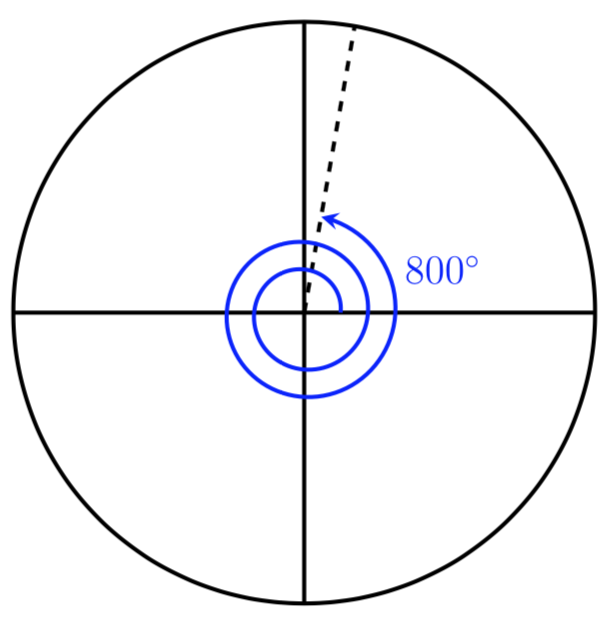
Example x
Detect an angle \(\alpha\) that is coterminal with \(870^\circ\) where \(0^\circ \leq \alpha \lt 360^\circ \text{.}\)
Solution
To find angles with the last sides pointing in the same direction, nosotros tin can decrease 360 degrees: \begin{equation*} \brainstorm{aligned} 870^\circ-360^\circ \amp= 510^\circ \\ 510^\circ-360^\circ \amp= 150^\circ \end{aligned} \end{equation*} Therefore \(870\) degrees is coterminal with \(150\) degrees.
Example 12
Depict an bending of \(-45^\circ\) on a circle and find a positive coterminal angle \(\alpha\) where \(0^\circ \leq \alpha \lt 360^\circ \text{.}\)
Solution
Since 45 degrees is half of 90 degrees, we can start at the positive horizontal axis and mensurate clockwise half of a 90 degree angle. We can find a positive coterminal angle by adding 360 degrees. \begin{equation*} -45^\circ+360^\circ=315^\circ \end{equation*} 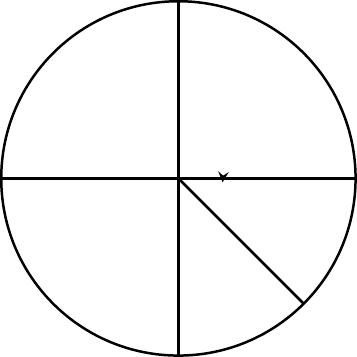
Example 13
Find an bending \(\beta\) that is coterminal with \(-300^\circ\) where \(0^\circ \leq \beta \lt 360^\circ \text{.}\)
Solution
Since \(-300^\circ+360^\circ=sixty^\circ\text{,}\) \(60\) degrees is coterminal with \(-300^\circ\text{.}\)
Subsection Measuring Angles in Radians
While measuring angles in degrees may be familiar, doing and so often complicates matters since the units of measure can make it the style of calculuations. For this reason, another measure of angles is commonly used. This measure is based on the altitude around the unit circumvolve.
The Unit Circle
The unit circle is a circle of radius 1, centered at the origin of the \((10,y)\) plane. When measuring an angle around the unit circumvolve, we travel in the counterclockwise direction, starting from the positive \(x\)-axis. A negative bending is measured in the opposite, or clockwise, management. A consummate trip around the unit of measurement circle amounts to a full of 360 degrees.

A radian is a measurement of an angle that arises from looking at angles as a fraction of the circumference of the unit circle. A complete trip around the unit circle amounts to a total of \(2\pi\) radians.
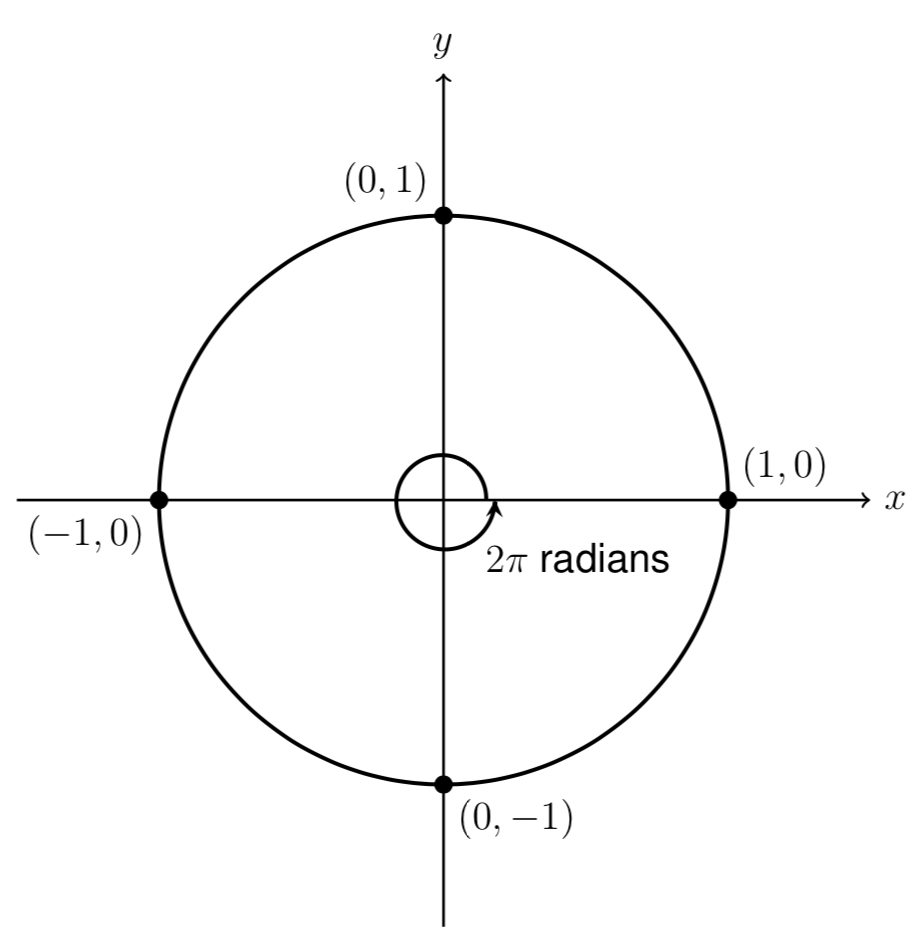
Radians are a unitless mensurate. Therefore, information technology is not necessary to write the label "radians" subsequently a radian measure out, and if y'all run across an angle that is not labeled with "degrees" or the degree symbol, you should assume that it is a radian measure.
Radians and degrees both measure angles. Thus, it is possible to convert between the ii. Since ane rotation around the unit of measurement circle equals 360 degrees or \(two\pi\) radians, we tin use this as a conversion factor.
Converting Between Radians and Degrees
Since \(360 \text{ degrees} = 2\pi \text{ radians}\text{,}\) we can divide each side by 360 and conclude that
\begin{equation*} \displaystyle 1 \text{ caste} = \frac{ii\pi \text{ radians}}{360} = \frac{\pi \text{ radians}}{180} \cease{equation*}
So, to catechumen from degrees to radians, we can multiply by \(\displaystyle \ \frac{\pi \text{ radians}}{180^\circ}\)
Similarly, we can conclude that
\begin{equation*} \displaystyle 1 \text{ radian} = \frac{360^\circ}{two\pi} = \frac{180^\circ}{\pi} \end{equation*}
So, to convert from radians to degrees, we tin can multiply by \(\displaystyle \ \frac{180^\circ}{\pi \text{ radians}}\)
Example 15
Convert \(\displaystyle \frac{\pi}{6}\) radians to degrees.
Solution
Since we are given an angle in radians and nosotros desire to convert information technology to degrees, nosotros multiply the angle by \(180^\circ\) and and then divide by \(\pi\) radians. \begin{equation*} \frac{\pi}{6} \text{ radians} \cdot \frac{180^\circ}{\pi \text{ radians}} = thirty^\circ \terminate{equation*}
Instance 16
Convert \(15^\circ\) to radians.
Solution
In this example, we beginning with an angle in degrees and desire to convert it to radians. We multiply by \(\pi\) and divide by \(180^\circ\) so that the units of degrees cancel and we are left with the unitless measure of radians. \begin{equation*} 15^\circ \cdot \frac{\pi}{180^\circ} = \frac{\pi}{12} \end{equation*}
Example 17
Catechumen \(\displaystyle \frac{vii\pi}{x}\) radians to degrees.
Solution
Since we are given an angle in radians and we want to convert it to degrees, we multiply by the angle \(180^\circ\) then split up past \(\pi\) radians. \begin{equation*} \frac{7\pi}{10} \text{ radians} \cdot \frac{180^\circ}{\pi \text{ radians}} = 126^\circ \terminate{equation*}
In a higher place, we explored how to find coterminal angles for angles greater than 360 degrees and less than 0 degrees. Similarly, nosotros can find coterminal angles for angles greater than \(2\pi\) radians and less than 0 radians.
Instance 19
Find an bending \(\beta\) that is coterminal with \(\displaystyle \frac{eleven\pi}{four}\) where \(0^\circ \leq \beta \lt ii\pi \text{.}\)
Solution
When working in degrees, we found coterminal angles past adding or subtracting 360 degrees, a full rotation. Likewise, in radians, we tin find coterminal angles by calculation or subtracting total rotations of \(two\pi\) radians. An angle of \(eleven\pi/4\) is coterminal with an angle of \begin{equation*} \frac{11\pi}{iv} - 2\pi = \frac{eleven\pi}{4} - \frac{viii\pi}{4} = \frac{three\pi}{4} \terminate{equation*} 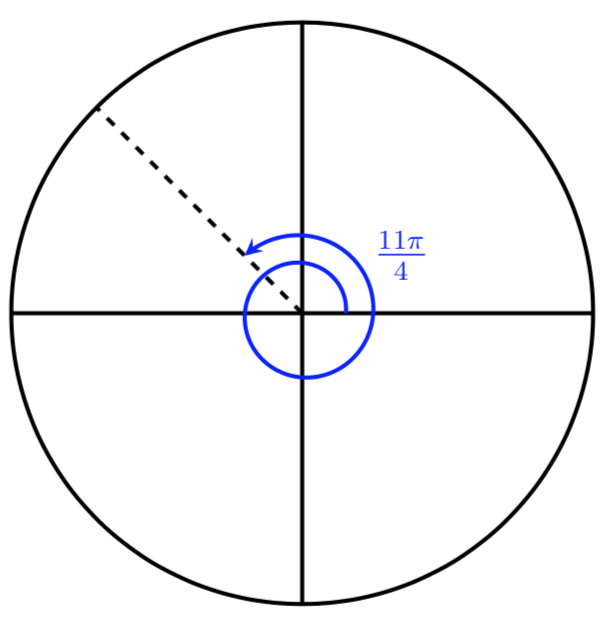
Example 20
Find an bending \(\phi\) that is coterminal with \(\displaystyle -\frac{11\pi}{6}\) where \(0^\circ \leq \phi \lt two\pi \text{.}\)
Solution
An angle of \(-\frac{11\pi}{6}\) is coterminal with an bending of \begin{equation*} -\frac{11\pi}{6} + 2\pi = -\frac{11\pi}{half-dozen} + \frac{12\pi}{6} = \frac{\pi}{half-dozen} \end{equation*}
Subsection Finding Points on the Unit of measurement Circle
While it is user-friendly to describe the location of a point on the unit circle using an angle, relating this angle to the \(10\) and \(y\) coordinates of the corresponding indicate is an of import awarding of trigonometry. To exercise this, we will demand to apply our noesis of triangles.
Case 21
Find the \((10,y)\) coordinates for the point on the unit circle corresponding to an angle of 45 degrees or \(\pi/iv\) radians.
Solution
Let's start by drawing a picture and labeling the known data. Nosotros want to discover the \(10\) and \(y\) coordinates of the point on the unit circle respective to an angle of 45 degrees or \(\pi/4\text{.}\) To exercise this, we can draw a vertical line from the betoken down to the \(x\)-axis, which forms a right triangle. The hypotenuse of this triangle is ane, since it corresponds to the radius of the unit circle, and the side lengths of this triangle are equal to \(x\) and \(y\text{.}\) Now, using the Pythagorean Theorem, nosotros become that \begin{equation*} x^two+y^ii=i^2 \hspace{.25in} \text{ which simplifies to } \hspace{.25in} ten^2+y^2=i \end{equation*} Since the triangle formed is a 45-45-90 degree triangle, side lengths \(10\) and \(y\) must exist equal. Therefore, nosotros tin can substitute in \(x=y\) into the higher up equation. \begin{align*} x^2+y^2 \amp = 1 \amp\amp \text{Substitute in } x=y \\ \\ 10^2+x^2 \amp = 1 \amp\amp \text{Add together similar terms } \\ \\ 2x^2 \amp = one \amp\amp \text{Split up by 2} \\ \\ x^2 \amp = \frac{i}{2} \amp\amp \text{Accept the foursquare root} \\ \\ x \amp = \pm\sqrt{\vphantom{\frac{1^2}{2}}\frac{one}{2}} \amp\amp \text{Since the } 10 \text{ value is positive, nosotros go along the positive root so} \\ \\ 10 \amp = \sqrt{\vphantom{\frac{ane^two}{2}}\frac{1}{ii}} \amp\amp \end{align*} Often this value is written with a rationalized denominator. Recollect that to rationalize the denominator, we multiply by a term equivalent to i to get rid of the radical in the denominator, so \begin{equation*} 10 = \sqrt{\vphantom{\frac{i^2}{ii}}\frac{1}{2}} \, \sqrt{\vphantom{\frac{i^2}{ii}}\frac{ii}{2}} = \sqrt{\vphantom{\frac{one^2}{2}}\frac{two}{4}} = \frac{\sqrt{2}}{2} \stop{equation*} and since \(x\) and \(y\) are equal, \(\displaystyle y=\frac{\sqrt{2}}{2}\text{.}\) Thus, the \((x,y)\) coordinates for the point on the unit circumvolve respective to an angle of 45 degrees or \(\pi/4\) radians are \begin{equation*} (10,y) = \left(\frac{\sqrt{2}}{2},\frac{\sqrt{2}}{two}\right)\text{.} \end{equation*} 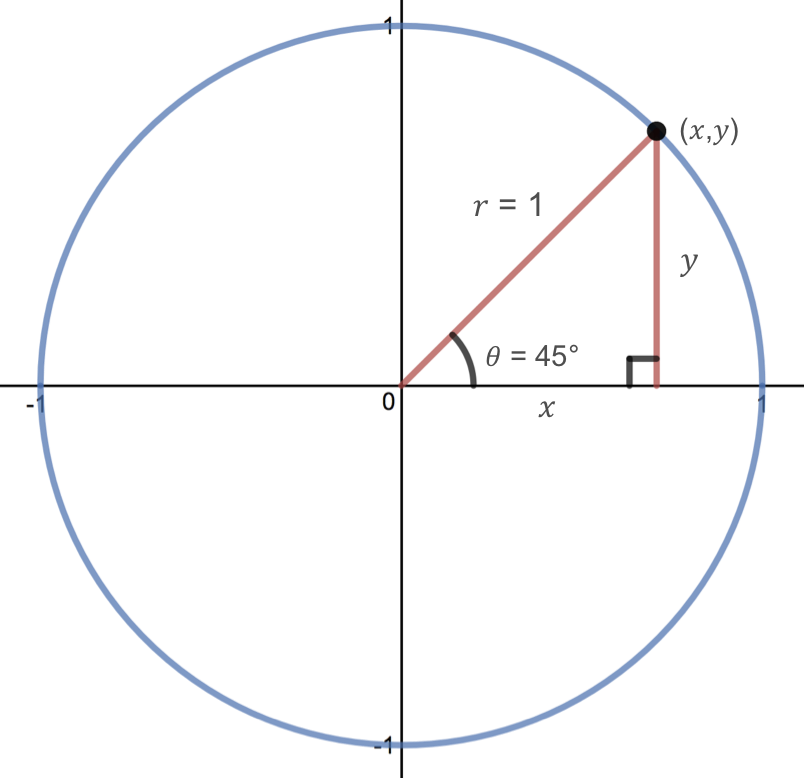
Example 22
Find the \((x,y)\) coordinates for the point on the unit of measurement circumvolve corresponding to an bending of 30 degrees or \(\pi/6\) radians.
Solution
Let'due south beginning by drawing a picture and labeling the known information. We desire to notice the \(x\) and \(y\) coordinates of the betoken on the unit of measurement circle corresponding to an bending of 30 degrees or \(\pi/6\text{.}\) To do this, we can draw a triangle inside the unit circumvolve with one side at an angle of 30 degrees and another at an angle of \(-30\) degrees. Notice that if nosotros combine the resulting 2 right triangles to form i large triangle, so all iii angles of the larger triangle are equal to 60 degrees. Since all of the angles in this triangle are equal, the sides volition all exist equal as well. Two of the side lengths of this triangle are equal to i considering they correspond to the radius of the unit of measurement circumvolve. Thus, the other side length must as well be equal to 1. This side as well has a length of \(2y\text{.}\) Therefore, we can conclude that \(2y = one\) then \begin{equation*} y=\frac{i}{2} \end{equation*} Now, we can employ the Pythagorean Theorem to one of the correct triangles to discover the \(x\) value. We get that \begin{align*} x^2+y^ii \amp = 1^2 \\ \\ x^2+\left(\frac{1}{2}\right)^ii \amp = one \\ \\ x^2+\frac{i}{4} \amp = 1 \\ \\ ten^ii \amp = \frac{3}{four} \\ \\ x \amp = \pm\sqrt{\vphantom{\frac{3^2}{4}}\frac{3}{iv}} \\ \\ ten \amp = \sqrt{\vphantom{\frac{3^2}{iv}}\frac{3}{4}} = \frac{\sqrt{3}}{two} \terminate{align*} Thus, the \((x,y)\) coordinates for the betoken on the unit of measurement circumvolve respective to an angle of 30 degrees or \(\pi/half-dozen\) are \brainstorm{equation*} (x,y) = \left(\frac{\sqrt{3}}{2},\frac{ane}{2}\correct)\text{.} \finish{equation*} 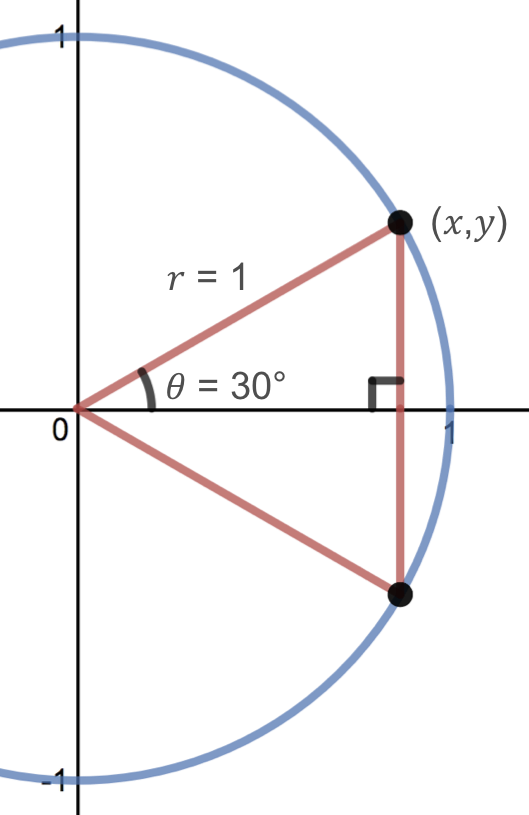
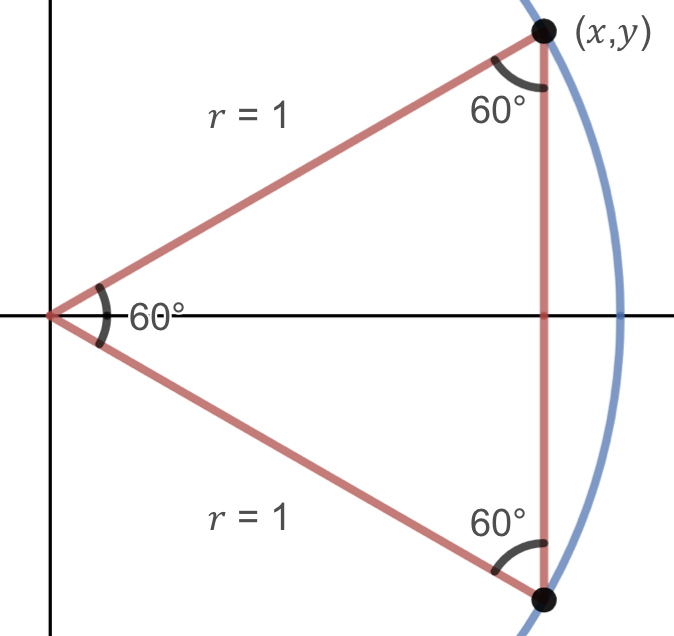
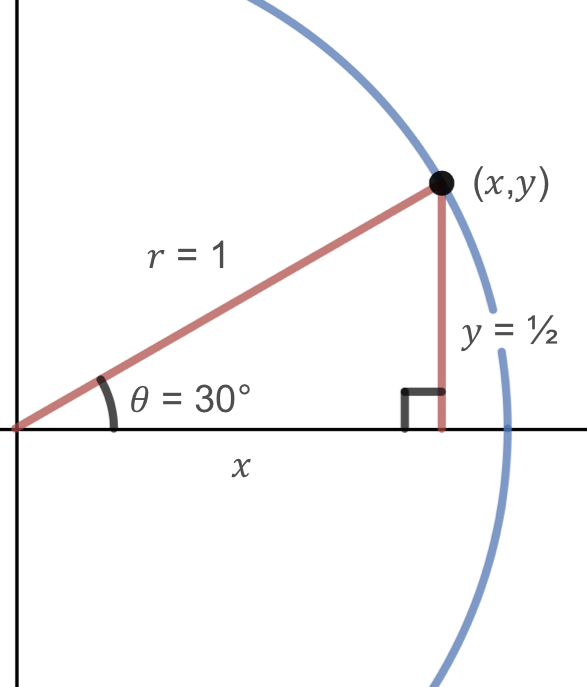
In the previous case, nosotros practical our noesis of triangles to find the \(x\) and \(y\) coordinates of the point on the unit of measurement circle corresponding to thirty degrees. We can at present utilise symmetry to find the \(10\) and \(y\) coordinates corresponding to an angle of 60 degrees or \(\pi/3\text{.}\) Commencement, we draw a picture of the triangle corresponding to this point on the unit circle.
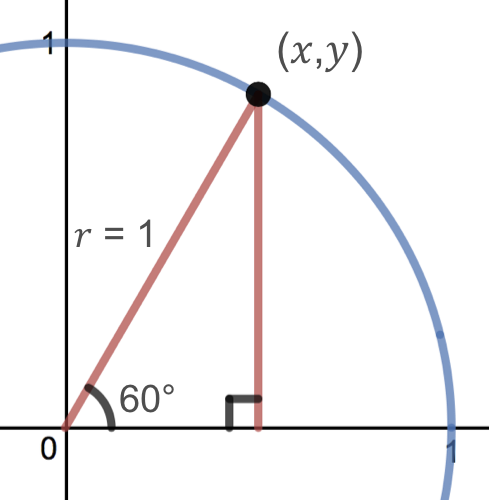
Find that the triangle shown higher up is similar to the ane formed by the 30 caste bending since the hypotenuse is the same length and both are 30-lx-90 degree triangles. Therefore, the \((x,y)\) coordinates for 60 degrees are the aforementioned as the \((x,y)\) coordinates for 30 degrees, only switched.
Thus, the \((x,y)\) coordinates for the indicate on the unit circle corresponding to an angle of 60 degrees or \(\pi/three\) are
\begin{equation*} (x,y) = \left(\frac{one}{two},\frac{\sqrt{3}}{two}\correct)\text{.} \end{equation*}
We have now found the coordinates of the points corresponding to all the unremarkably encountered angles in the first quadrant of the unit circle. Using symmetry, we can find the residue of the coordinates respective to common angles on the unit circle. A labeled picture show of the unit of measurement circumvolve is shown below.
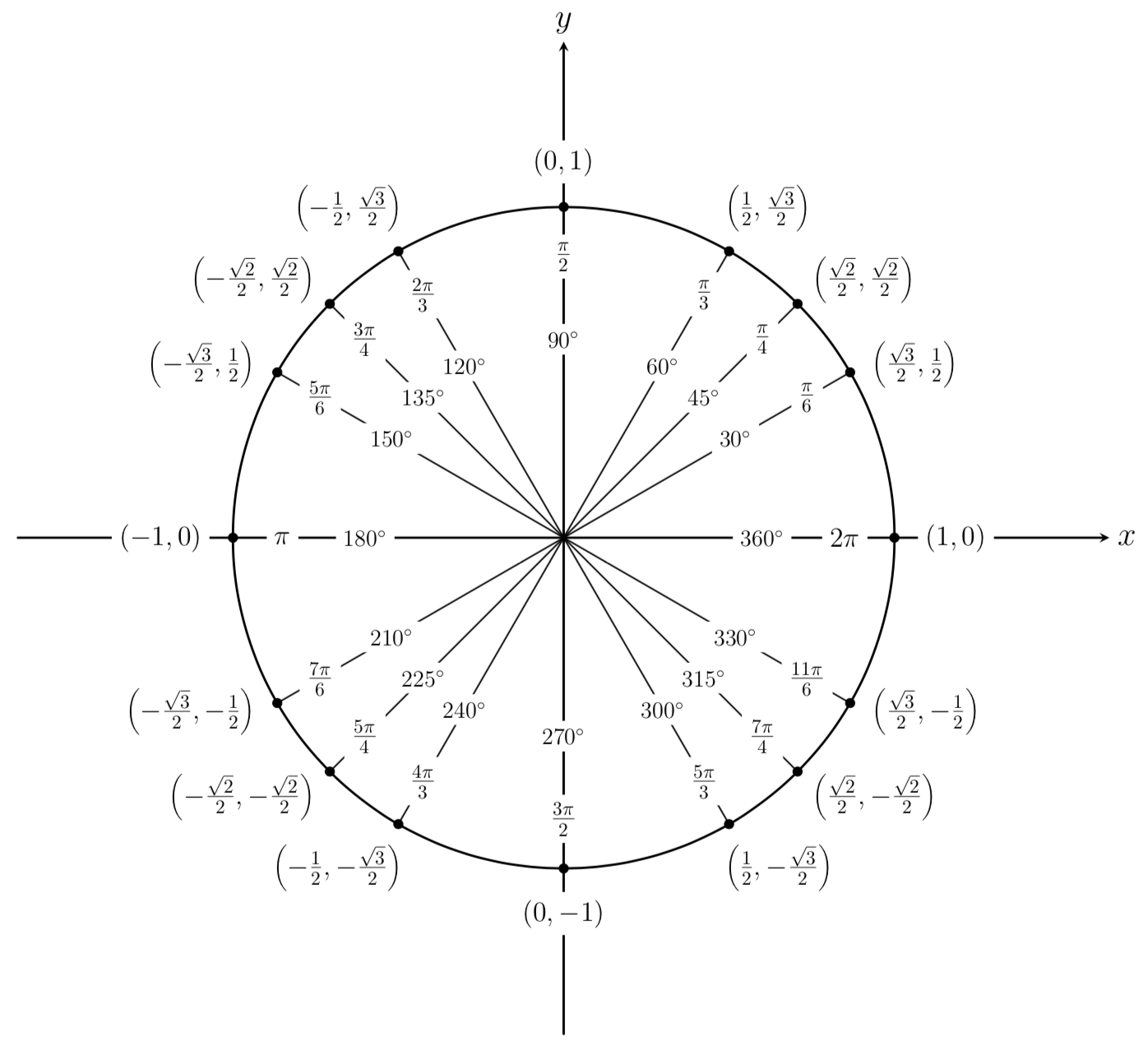
Subsection Supplemental Videos
- Measuring Angles
- Coordinates on the Unit of measurement Circle
- Examples
Subsection Exercises
ane Converting Degrees to Radians
2 Converting Radians to Degrees
iii Converting Between Degrees and Radians
4 Applied Converting Between Degrees and Radians
Source: https://mathbooks.unl.edu/PreCalculus/unit-circle.html
0 Response to "what angle in radians corresponds to 0.40 rotations around the unit circle?"
Publicar un comentario